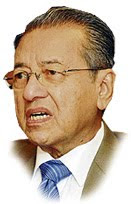Saturday May 9, 2009
Is global money good for Asia?
Think Asian by Andrew Sheng
THE world has certainly changed when two friends, one from the United States and one from Britain, suddenly sent me an email to ask what I thought of People’s Bank of China Governor Zhou Xiaochuan’s call for a global currency.
Of course, the blogspace amongst financial specialists went into a hyper-frenzy of analysis whether the US dollar was in decline, but my friends are not finance people – one a doctor, the other a retiree. Ordinary people were clearly concerned. I could not answer immediately because I had to first read Governor Zhou’s paper carefully.
One investment bank research analysis suggested that the People’s Bank is doing a series of research papers on global finance and this was the first of the think-pieces.
Because of her size, China has to move from the mindset of an emerging market economy to a major player in the global financial architecture with global social responsibilities.
The question that Governor Zhou posed is an excellent one – whether we should have a national currency, such as the US dollar, as the global reserve currency, or whether we should have a global currency, issued by a global authority, not one single nation.
This question is known as the Triffin Dilemma, named after Belgian Yale Professor Robert Triffin, who became a US citizen and one of the best international economists in the 1960s.
He was looking into the question whether the US, as the dominant economic power, could sustain the role of the US dollar at a time when she began to run current account and fiscal deficits in the 1960s due to the cost of the Vietnam War.
This was the period when the US dollar was still fixed to gold at the price of US$35 per ounce and the US held the largest gold reserves in the world. French President De Gaulle got into trouble with the United States in the 1960s when he insisted on being paid in gold rather than in dollars.
But in 1971, when the deficits did get too large, the US abandoned the linkage to gold and floated the currency, which also led to the high inflation in the 1970s that was only ended when Paul Volcker, then chairman of the Federal Reserve Bank, decided to use high interest rates to squeeze inflation expectations out of the US economy.
That recession helped improve US productivity and prepared the US for the long run of growth in the 1990s. The replacement of gold with paper currency solved one major problem. If the supply of gold is fixed, whilst the global economy is growing, then prices will be deflationary – meaning that prices of goods relative to gold will shrink.
Ideally, to have no inflation, the supply of gold must grow at the same rate as the rate of global goods production. Thus, using a gold standard benefited the gold producing countries, but not the rest of the world.
However, if a national currency replaced gold, then the rate of increase in the national currency should be the same as global growth in order to maintain global liquidity and stable inflation.
The issuing nation benefits from the seigniorage from the issue – meaning that the country could earn from the interest rate earned on the currency issue, since the cost of printing money was almost zero.
The Triffin Dilemma is that if the issuing country’s inflation rate is different from the rest of the world, then to maintain global liquidity, the issuing country’s monetary policy must fit global conditions, rather than national conditions.
Such a global role can have its benefits, because of the seigniorage profits, but it can be highly costly if the issuing country has to print money not for itself, but for the rest of the world. Thus, a global issuer has to sacrifice its own national interests for global interest, and it is rewarded by seigniorage and the inflow of foreign funds.
The global issuer then becomes the global bank, because it has to run by definition a current account deficit equivalent to the amount of additional liquidity that the rest of the world needs.
This is the true origin of the Global Imbalance. The real risk is that the issuing country runs too large an imbalance and then the lending countries will take away their funds, causing massive devaluation and a global deflation.
Thus, the Global Imbalance is really the direct result of Global Money and Global Governance. I always felt that the position of the US Federal Reserve is in reality the central bank of the world, because as long as the US dollar is a global reserve currency, the Fed has to be the US dollar lender of last resort.
The Asian region was a dollar region until 1997, because we all believed in the US dollar. When the Fed refused to be the dollar lender of last resort during the Asian crisis, this meant that Asians could not depend on the US as a banker to borrow from in times of crisis. The only logical conclusion was to build up sufficient reserves and not to depend on foreigners. The self insurance after the Asian crisis worsened the Global Imbalance. If the Fed is not the global banker, can the IMF be the global banker? I shall answer this in another article.
·Datuk Seri Panglima Andrew Sheng is adjunct professor at Universiti Malaya, Kuala Lumpur, and Tsinghua University, Beijing. He has served as adviser and chief economist to Bank Negara, deputy chief executive of the Hong Kong Monetary Authority and chairman of the Hong Kong Securities and Futures Commission.
Subscribe to:
Post Comments (Atom)







































1 comment:
Professor Triffin's insights about the need to move to a global currency were visionary. The world should be grateful to China and the U.N. Panel led by Nobel Laureate Joseph Stiglitz for leading the way to a Single Global Currency, which will be managed by a Global Central Bank within a Global Monetary Union. Their interim proposals for a new "reserve currency" is only a first step toward long term global monetary stability.
As China requests, this next global currency will not be the
responsibility of just one country. What is needed now is international recognition of those goals, and research and planning to achieve them.
The success of the euro shows that monetary union is the best way to
ensure monetary stability. The primary problem with the euro and
currencies of other monetary unions is that they still must co-exist within the international multi-currency system itself where the value of those common currencies must still fluctuate in value against each other.
If 16 countries can use the same currency, why not 192?
In addition to eliminating currency risk, the use of a Single Global Currency would eliminate the current foreign exchange trading expense of $400 billion annually, eliminate current account imbalances, eliminate the need for foreign exchange reserves (now totaling more than $3 trillion); and bring other benefits worth trillions.
The Single Global Currency Assn. (www.singleglobalcurrency.org)
promotes the implementation of a Single Global Currency by 2024, the 80th anniversary of the 1944 conference. That's only 15 years away.
The world is moving toward a Single Global Currency through the
creation, expansion and merger of regional monetary unions. Countries could also form ad hoc monetary unions by "izing" their countries to a major currency as Ecuador and El Salvador did by "dollarizing" and as Montenegro and the Vatican did by "euroizing." Another route is through international
monetary conferences proposals and agreements, such as were seen at
Bretton Woods in 1944.
The challenge now is to reach that goal deliberately, as soon as possible with as little cost and as few crises as possible.
See the book, "The Single Global Currency - Common Cents for the World."
Morrison Bonpasse
Single Global Currency Assn.
Newcastle, Maine, United States
Post a Comment